Greetings, Conscientious Food Consumers!
As autumn approaches, we can all look back on how our lives have changed since March, and the reality of COVID-19. Like most everything else, No Food Left Behind Corvallis has transitioned online, and in April we launched “Kitchen Confessions.” 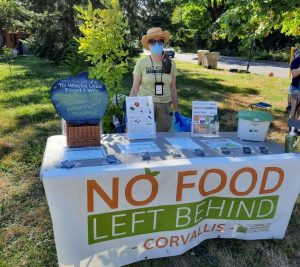
Before COVID-19, NFLB’s outreach happened in the schools, community presentations, and through all-seasons tabling at the Corvallis Farmers’ Markets — we miss seeing everyone! Although we are doing limited outreach at the Corvallis Southtown Farm Stand & Market (pictured), we’re not reaching as many of you in person now.
Now more than ever, NFLB — a project of the Corvallis Sustainability Coalition’s Waste Prevention Action Team (WPAT) — is here to support you in conscientiously developing smart, money-saving approaches for making the most of the food in your home during this pandemic, and beyond.
So with this installment of “Kitchen Confessions,” we’re highlighting a few Frequently Asked Questions (FAQs) that we hear regularly.
“Are you with the gleaners?”
NFLB is not involved in gleaning, but we love promoting local groups like Mid-Valley Harvest and our Coalition partners, Linn-Benton Food Share and the Marys River Gleaners! These volunteer-driven organizations are helping local property owners, from small rural farmers to your neighbor down the street, manage the bounty that would otherwise go unharvested and rot on the ground. They welcome your energy and financial donations.
“WPAT? What’s that about?”
The Waste Prevention Action Team’s (WPAT) vision for Corvallis is “a waste-free community that fosters behaviors to reduce consumption of material goods.” Strategies include significantly increasing the community’s recycling rate, and diverting hazardous waste and other materials from the landfills — especially wasted food.
We’ve got a big problem there, with almost half of Corvallis residents throwing wasted food into the garbage instead of using the Yard Debris carts provided by local hauler and Coalition partner Republic Services. You can even toss nasty wasted meat, bones and dairy items into the Yard Debris cart!
The video at the bottom of our composting page describes the serious industrial-scale processes used by Republic to create a high-quality compost product. (Note: this curbside composting service is currently available only in Corvallis and Philomath.)
“What about composting? Do you teach people how?”
Composting, and how-to, is not our focus with NFLB. We’re focused on what happens before food gets turned into compost! If something that was edible in the first place ends up in your compost bin or yard debris cart, it was technically still wasted. Just think of all the resources that went into getting that food from farm to fork.
What we do try to teach is how to avoid the waste that has to end up in the compost, and we provide many tools to make that easier!
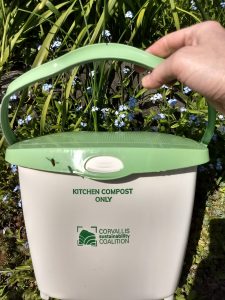 Utilizing organic waste matter to create new soil is great, and we highly encourage this practice over throwing food away. That’s also why we offer these handy kitchen compost pails — made from recycled plastic, of course! — that you may have seen at our Farmers’ Market table. You can get one of these popular counter-top compost pails for free, or help offset our cost through a tax-deductible donation.
Utilizing organic waste matter to create new soil is great, and we highly encourage this practice over throwing food away. That’s also why we offer these handy kitchen compost pails — made from recycled plastic, of course! — that you may have seen at our Farmers’ Market table. You can get one of these popular counter-top compost pails for free, or help offset our cost through a tax-deductible donation.
If you’re just getting started, here’s an intro to composting, along with many other informative publications from our local experts at the OSU Extension Service. Additional advice is also available from Extension volunteer Master Gardeners.
“Are you a volunteer group? Who are you funded by?”
As a project of the volunteer-driven Sustainability Coalition and WPAT, No Food Left Behind’s current staff and operations are grant funded by the Oregon Department of Environmental Quality (DEQ), in contract with the non-profit Corvallis Sustainability Coalition. We are proud to support the Corvallis Climate Action Plan goals, as well as DEQ’s long-standing work on food waste prevention and its response to Governor Brown’s March 10, 2020 directive (p7) “to prevent and recover food waste, with the goal of reducing food waste by 50 percent by 2030.”
You can read our 2018-19 DEQ Final Report here.
“What about all the food waste happening in restaurants and grocery stores?”
It is a huge problem, estimated to cost U.S. businesses $57 billion annually, while creating mountains of waste in landfills and climate-changing methane emissions. However, a 2017 study revealed that the greatest amount of wasted food happens at home! That’s why it is NFLB’s focus.
Oregon businesses are making great progress in addressing this problem with help from DEQ’s “Wasted Food Wasted Money” campaign. as well as Metro Portland’s Food Waste Stops With Me program, in cooperation with industry associations like the Oregon Restaurant & Lodging Association. Businesses receive free resource guides, on-site assistance to train employees in food waste prevention, and ways to donate edible surplus food and set up on-site composting programs.
This Week’s Kitchen Confession:
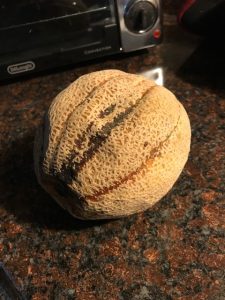 KAREN CONFESSES:
KAREN CONFESSES:
This sad specimen of ruined cantaloupe was destined for a fresh fruit salad or ice cream/yogurt bowls. Following my handy Fruit and Vegetable Storage Guide, I put it on my counter to ripen for a couple of days, and then stowed it in the “Eat First” area of my fridge… where it somehow migrated to the back. It was shriveled, over-ripe and moldy on the bottom by the time I retrieved it!
$$$ WASTED: $3-$4
LESSONS LEARNED: Cut/prep the melon for that fruit salad the same day it goes into the fridge! Make more room for my “Eat First!” items. Place cut melon in a labeled or see-through container in my “Eat First” area AND make a note on my weekly Meal Planner.
We look forward to supporting you and your loved ones through the coming months of the COVID-19 era. Be Well!


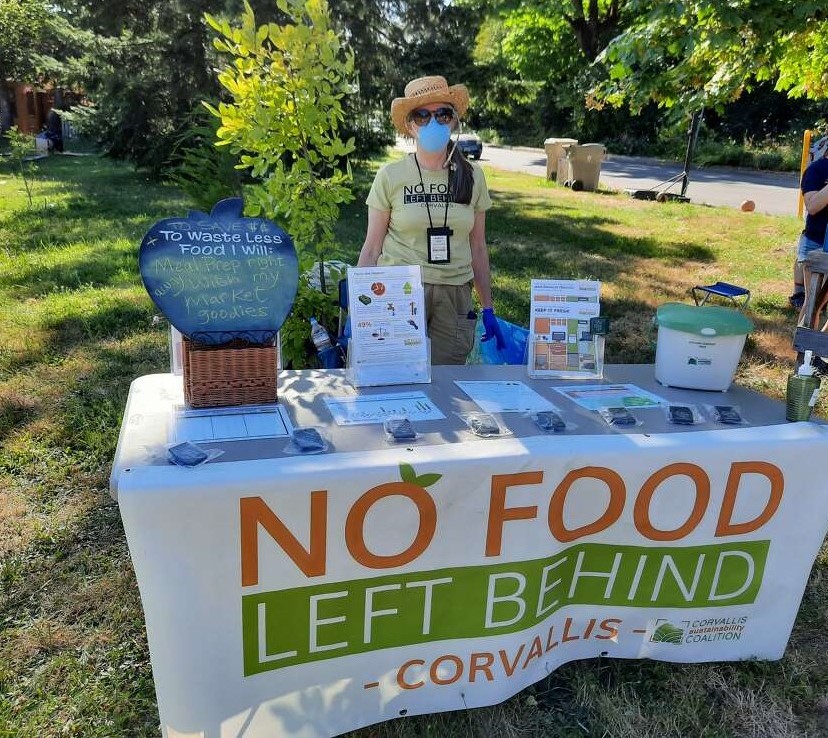
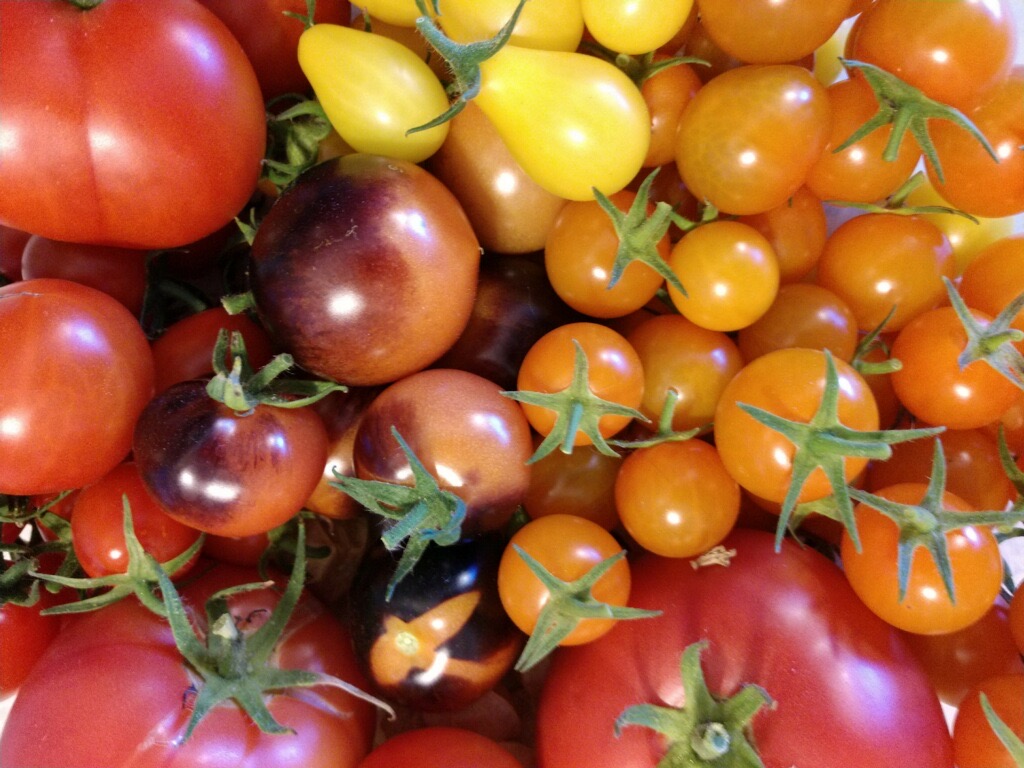
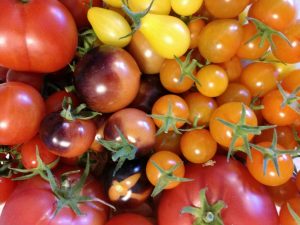
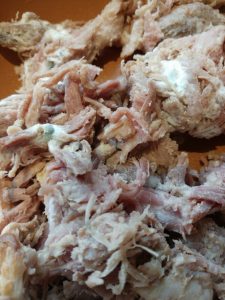
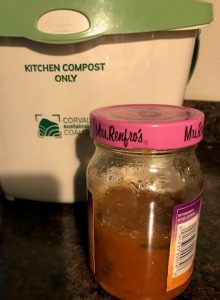 KAREN CONFESSES: Before local tomatoes were in season, I bought mild sweet mango salsa which my son likes, and we enjoyed it with one meal of burritos and nachos. He went home afterwards and I placed the opened jar in the fridge door with the rest of my condiments. Since I prefer a green chile-based salsa (a bit more spicy), it tends to get used first and, eventually, I was dismayed to find a “science experiment” brewing inside the mango salsa jar.
KAREN CONFESSES: Before local tomatoes were in season, I bought mild sweet mango salsa which my son likes, and we enjoyed it with one meal of burritos and nachos. He went home afterwards and I placed the opened jar in the fridge door with the rest of my condiments. Since I prefer a green chile-based salsa (a bit more spicy), it tends to get used first and, eventually, I was dismayed to find a “science experiment” brewing inside the mango salsa jar.